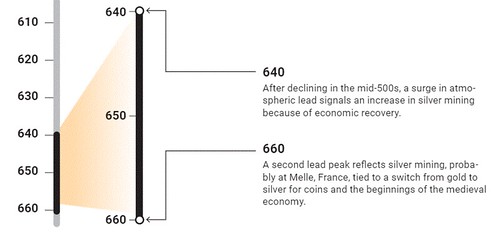
PREV ARTICLE
NEXT ARTICLE
FULL ISSUE
PREV FULL ISSUE
GLACIER ICE SAMPLES TRACK SILVER COIN USELen Augsburger passed along this 2018 Science Magazine article about the darkest hours of the Dark Ages. -Editor Ask medieval historian Michael McCormick what year was the worst to be alive, and he's got an answer: "536." Not 1349, when the Black Death wiped out half of Europe. Not 1918, when the flu killed 50 million to 100 million people, mostly young adults. But 536. In Europe, "It was the beginning of one of the worst periods to be alive, if not the worst year," says McCormick, a historian and archaeologist who chairs the Harvard University Initiative for the Science of the Human Past. A mysterious fog plunged Europe, the Middle East, and parts of Asia into darkness, day and night—for 18 months. "For the sun gave forth its light without brightness, like the moon, during the whole year," wrote Byzantine historian Procopius. Temperatures in the summer of 536 fell 1.5°C to 2.5°C, initiating the coldest decade in the past 2300 years. Snow fell that summer in China; crops failed; people starved. The Irish chronicles record "a failure of bread from the years 536–539." Then, in 541, bubonic plague struck the Roman port of Pelusium, in Egypt. What came to be called the Plague of Justinian spread rapidly, wiping out one-third to one-half of the population of the eastern Roman Empire and hastening its collapse, McCormick says.The numismatic connection? Analysis of ice from a Swiss glacier tracks the emergence of silver mining and the use of silver in coinage. -Editor 
Silver was smelted from lead ore, so the lead is a sign that the precious metal was in demand in an economy rebounding from the blow a century before, says archaeologist Christopher Loveluck of the University of Nottingham in the United Kingdom. A second lead peak, in 660, marks a major infusion of silver into the emergent medieval economy. It suggests gold had become scarce as trade increased, forcing a shift to silver as the monetary standard, Loveluck and his colleagues write in Antiquity. "It shows the rise of the merchant class for the first time," he says. Still later, the ice is a window into another dark period. Lead vanished from the air during the Black Death from 1349 to 1353, revealing an economy that had again ground to a halt. "We've entered a new era with this ability to integrate ultra–high-resolution environmental records with similarly high resolution historical records," Loveluck says. "It's a real game changer."
To read the complete article, see:
THE BOOK BAZARREWayne Homren, Editor The Numismatic Bibliomania Society is a non-profit organization promoting numismatic literature. See our web site at coinbooks.org. To submit items for publication in The E-Sylum, write to the Editor at this address: whomren@gmail.com To subscribe go to: https://my.binhost.com/lists/listinfo/esylum All Rights Reserved. NBS Home Page Contact the NBS webmaster 
|